Almost a decade before the Golgari were introduced in Ravnica, Magic’s first Green-Black cards were printed in Mirage: combo deck progenitor Cadaverous Bloom and the less-heralded Grim Feast. A year prior, though, there was an unofficial Green-Black card that set the tone for future Golgari staples; Ice Age’s Lhurgoyf may only have Green mana in that righthand corner, but the grisly scavenger was always happiest when paired with its enemy.
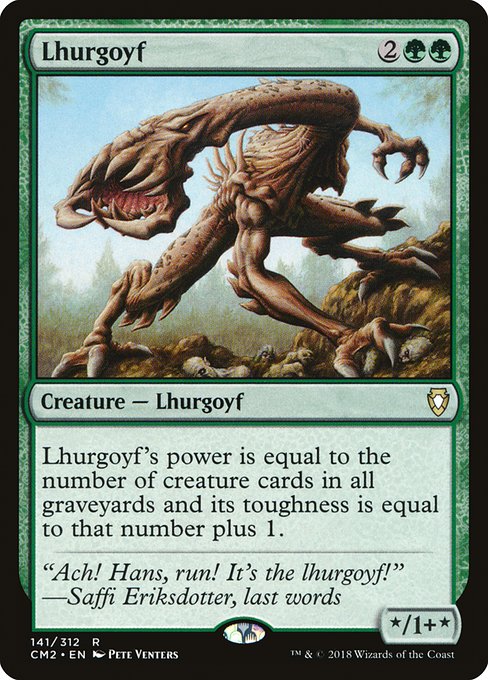
Lhurgoyf never hit the top tables, with Svend Geertsen’s 1997 Worlds one-of as the most prominent play it saw. But for casual players, and especially multiplayer fanatics, it was inspiring–for half the price of a Crash of Rhinos you could theoretically get a 16/17 creature. In the era of Force of Nature and Lord of the Pit, Lhurgoyf–and later, Revenant–were attractive to a certain mode of player. Big creatures, we had learned, usually had significant drawbacks; Lhurgoyf presented a different kind of puzzle–how could we optimize our decks to make this the biggest threat at the table?
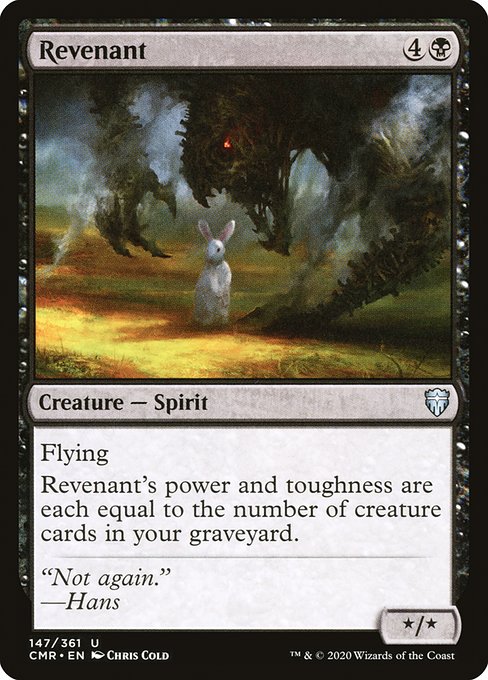
Lhurgoyf was legal in Standard from 1995-1999, thanks to a reprint in Fifth Edition, but it remained a casual icon–still, it was memorable and exciting. The graveyard-focused Odyssey block brought with it a cycle of Lhurgoyfs: Cantivore, Cognivore, Mortivore, Magnivore, and Terravore, all of whom counted different card types in the graveyard. The closest to the original Lhurgoyf was Mortivore, who traded one point of toughness for Regeneration and swapped colors from Green to Black. Mortivore saw only fringe play; the only successful member of this cycle was Magnivore, and even then, only years later when reprinted in 9th Edition into an extremely odd Standard environment.
It wasn’t all bad for the creature type: a better Goyf was waiting in the wings–one that would define tournament Magic for the next decade. Tarmogoyf even kept the original ‘Goyf’s oddball X/X+1 stats, allowing opposing Lhurgoyfs to bounce off each other, just as they did back in 1995.
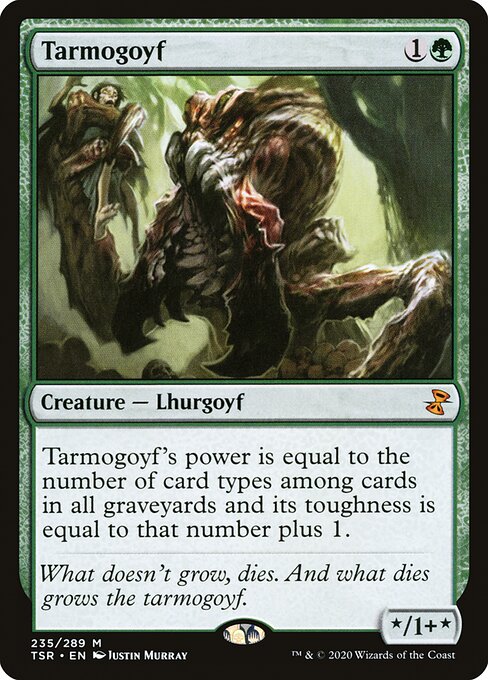
Aside from being a decent counter to an opponent’s Goyf, Tarmogoyf was so good because it scaled early in the game beyond an opponent’s ability to interact with it; a fetchland into a Thoughtseize taking their creature or Thoughtseize meant it was out of Lightning Bolt range as early as turn two.
Alas, the printing of Fatal Push was the start of Tarmogoyf’s fall from grace, a shift in Modern’s metagame, and aggressive graveyard hate in the last few years has been another nail in the former monarch of Modern’s coffin. Still, I have fond memories of mid-teens Modern, where Tarmogoyf commanded respect and $100 a copy, so it’s always exciting to see a new Lhurgoyf variant.
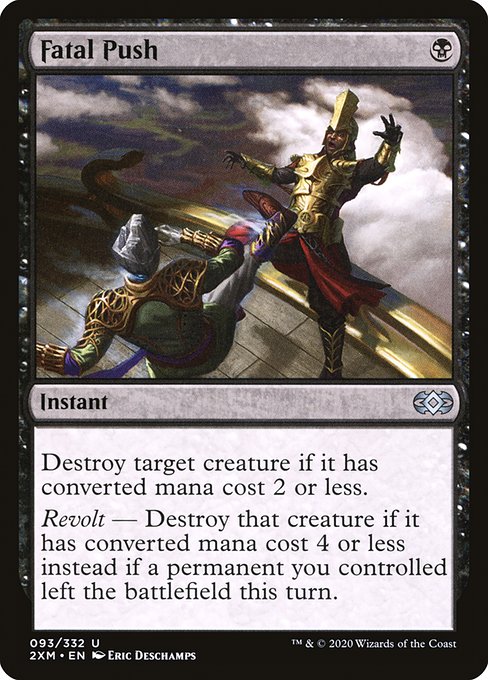
We’ve been lucky enough to get not one but two Mortivore analogues in Standard, with Dominaria United’s Urborg Lhurgoyf and Wilds of Eldraine’s Cruel Somnophage. Going all-in (or almost all-in) on creatures does restrict us, and Urborg Lhurgoyf only counts its controller’s graveyard anyway, but any time we have access to two creatures that reward the same strategy, it’s worth exploring.
The issue is that there’s a preponderance of incidental graveyard removal in Standard right now. Efficient sideboard cards like Unlicensed Hearse and Agatha’s Soul Cauldron, Graveyard Trespasser, Lord Skitter, Sewer King, and the Crimson Vow Cemetery cycle are main-deck playable by stats alone.

I drafted an all-creature Lhurgoyf deck and crashed it into the Best-of-One queues, which tend to be forgiving to janky brews, and went 1-6, only winning that one game due to an early Sheoldred. A more moderate version–30 creatures, 7 interaction spells–went 2-5, and I gave up on the cause for the moment. Perhaps Caverns of Ixalan will give us a third Lhurgoyf or a Dredge-style mechanic, but in the meantime, this is less Hogaak and more pre-Dredge Ichorid.
Here’s what I’ve been running:
3 Haywire Mite
4 Cruel Somnophage
2 Razorlash Transmogrant
2 Bramble Familiar
4 Urborg Lhurgoyf
4 Mosswood Dreadknight
1 Graveyard Trespasser
1 Scrapwork Rager
4 Sheoldred, the Apocalypse
2 Sheoldred
2 Virtue of Persistence
3 Liliana of the Veil
2 Wrenn and Realmbreaker
3 Undercity Upheaval
4 Deathcap Glade
4 Llanowar Wastes
2 Restless Cottage
1 Restless Vinestalk
1 Yavimaya Coast
1 Underground River
2 Takenuma, Abandoned Mire
1 Boseiji, Who Endures
4 Swamp
3 Forest
SB
4 Graf Reaver
3 Graveyard Trespasser
1 Boseiju, Who Endures
3 Rankle’s Prank
2 Jace, the Perfected Mind
2 Sheoldred
Our ten non-creature spells include Virtue of Persistence, which helps us live through the early game of the omnipresent Red deck, and a selection of Planeswalkers that advance our agenda–Wrenn and Realmbreaker could easily be Tyvar, Jubilant Brawler, but the mana fixing offered by Wrenn has been beneficial so far. This deck, as should be self-evident, folds to Sheoldred, the Apocalypse, which is my primary reason for warding you away from it. Sheoldred may not be as omnipresent as some former format boogeymen, but you absolutely need to have a plan to deal with her, beyond “play your own Sheoldred to counteract the life loss.” When you’re trying to play more than 30 creatures, you’re out of space for Go for the Throat, Tear Asunder or Hero’s Downfall. Sheoldred also trades for even the biggest Goyf/Somonophage, so even if you flawlessly execute your plan, one of the more common Standard cards can easily square up against you.
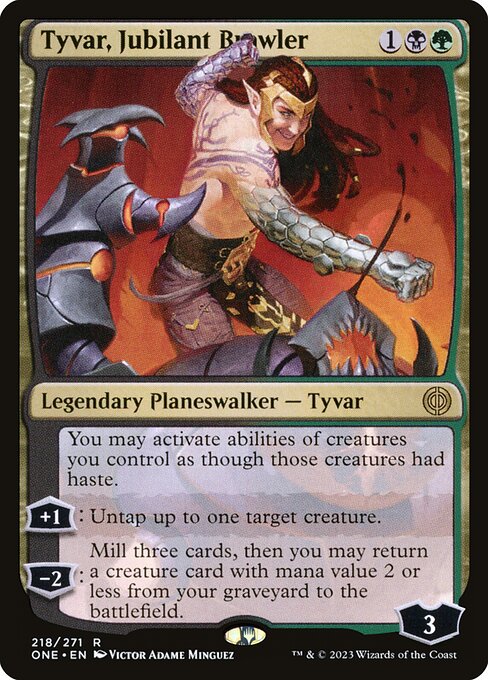
Still, while the dream of the Tarmogoyf may be dead, there were some surprises. The most impressive card in any of my tests–aside from Sheoldred–was Undercity Upheaval. It wasn’t out of the question for the 1GG Sorcery to drop five or six counters on my creatures, and the addition of Vigilance means you could swing with a 7/8 Lhurgoyf and 8/8 Somophage and still keep them back to block. Haywire Mite in the maindeck was low-impact but a nice security blanket, blocking and blanking a Monastery Swiftspear and a Kumano Faces Kakkazan. There’s a potential version of this deck that focuses more on Somnophage–trading resources and treating the pseudo-Lhurgoyf as more of a Death’s Shadow finisher than an aggressive deck.
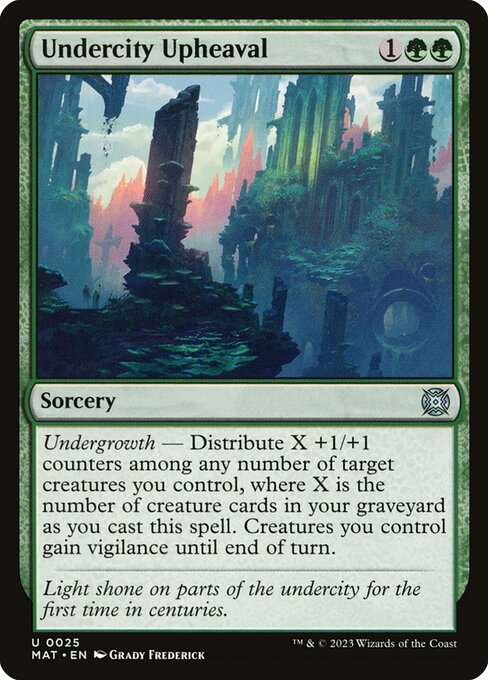
There’s something wonderful about absolutely tanking with a new deck. This deck lost, in short order, to Mono-Haste Mono-Red, Haughty Djinn, Mono-Black Rats, an Urabrask and thirty one-drop spells deck, Golgari Blossoming Tortoise, and its own mana.
In many of those matches, it folded with the speed and streamlined simplicity of a well-designed lawn chair. I basically served as Gold-tier Arena players’ goldfish for an hour and a half. I dropped so many games, so quickly, that I showed up on the Wikipedia page for shovelware. But building a brew from scratch, running it into a gauntlet of tier-two decks, and being thoroughly humbled is part of Magic–from the staple 0-3-drop at major tournaments to the old fashioned FNM flameout–and it’s not a failure. This is a game that rewards exploration, and sometimes exploration ends in a complete deadend. As long as Wizards keeps printing Golgari Lhurgoyfs, I’ll be there to try to self-mill my way to a massive creature, no matter how hostile the format.
Rob Bockman (he/him) is a native of South Carolina who has been playing Magic: the Gathering since Tempest block. A writer of fiction and stage plays, he loves the emergent comedy of Magic and the drama of high-level play. He’s been a Golgari player since before that had a name and is never happier than when he’s able to say “Overgrown Tomb into Thoughtseize,” no matter the format.

